Contents
Letters from IFDC’s Leadership
Our 50-Year Legacy | Our Results in 2024
Develop Better Technologies | Catalyze Farm Productivity | Strengthen Markets | Enable Impact
Publications & Presentations | Financials | Publication Credits
Download the Annual Report
Letters from IFDC’s Leadership
A Journey of Growth
As we present IFDC’s 2024 Annual Report, I am pleased to reflect on a year of growth, collaboration, and continued commitment to advancing sustainable agriculture and food security across the globe.
This year, the organization has made significant advancements in enhancing sustainable agricultural practices and strengthening food security worldwide. Through our training initiatives, we reached 374,402 farmers (54% being women), equipping them with essential knowledge on improved agricultural practices and innovative technologies. Demonstration plots served as crucial learning sites, with 9,566 established to showcase the effectiveness of management practices in real conditions.
As a result, 509,515 hectares were cultivated using good agricultural practices, while 173,887 hectares benefited from climate-adaptive technologies. These efforts translated into 432,986 farmers actively applying improved agricultural techniques, reinforcing IFDC’s mission to drive sustainable transformation in the sector.
Read Neal Gutterson’s letter below
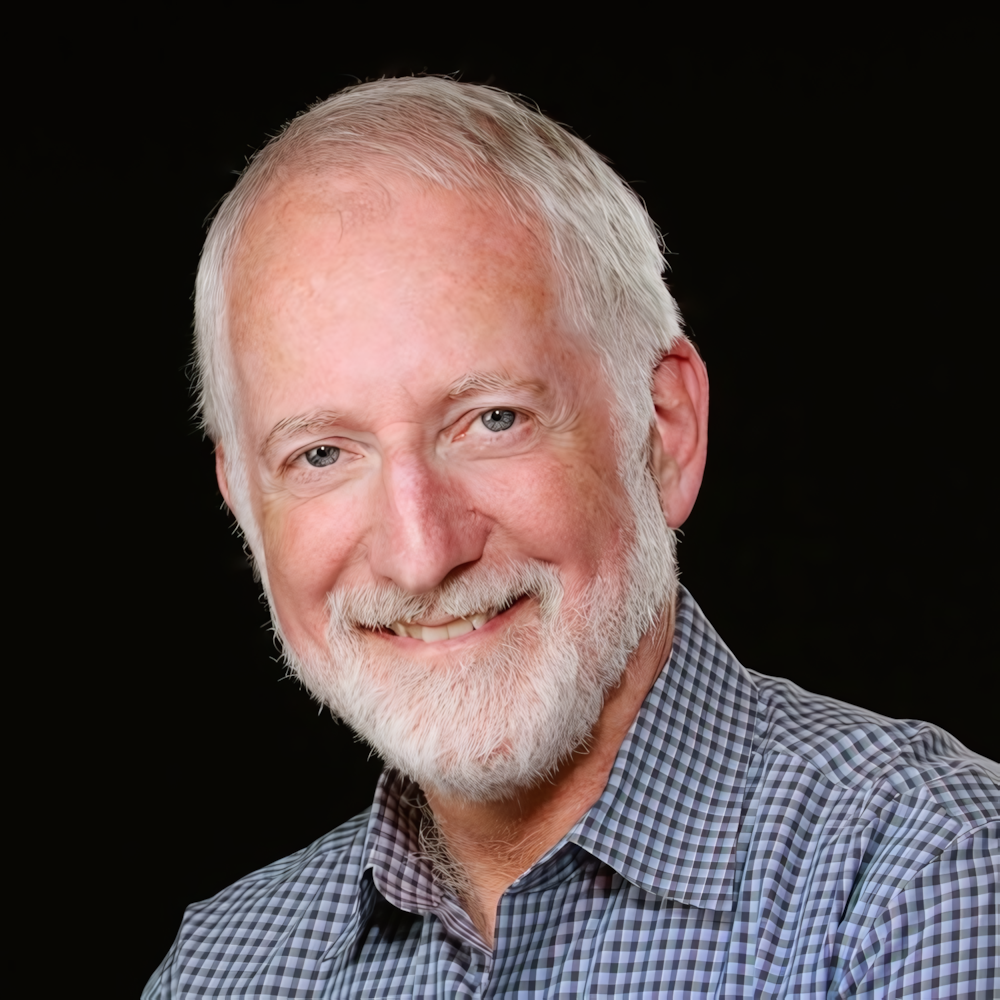
A letter from the Chair of the Board
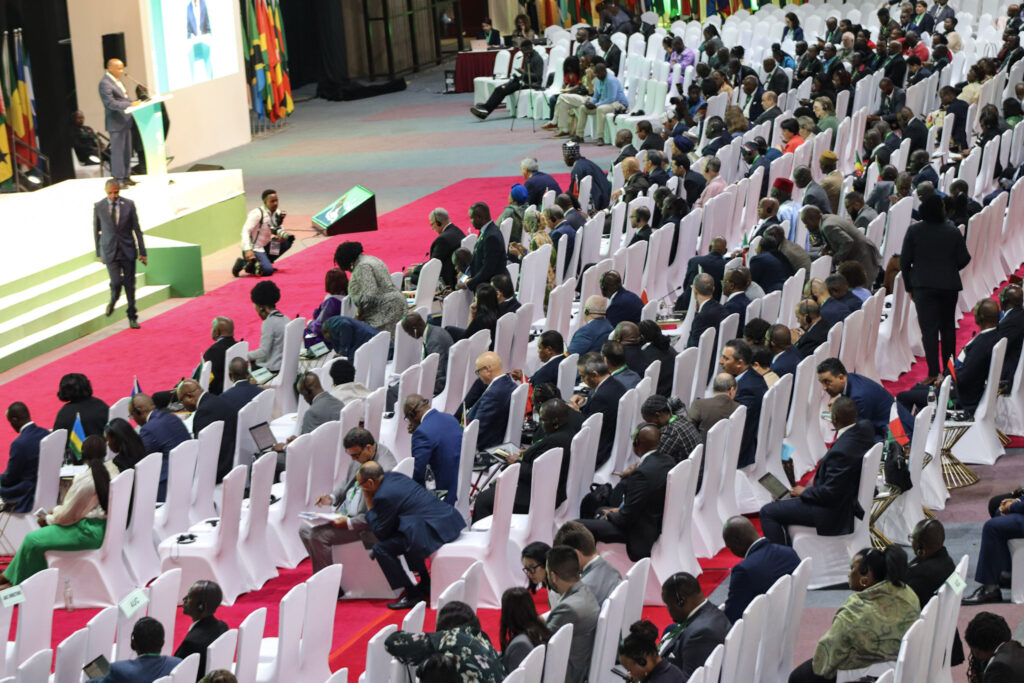
In 2024, IFDC provided support for the Africa Fertilizer and Soil Health (AFSH) Summit, advancing the Soil Initiative for Africa (SIA) to anchor soil health in Africa’s Agenda 2063.
This crucial African Union initiative brought together leaders, experts, and stakeholders from across the continent and beyond to address the critical issues of soil degradation and sustainable fertilizer use.
During the AFSH Summit, IFDC, the International Institute of Tropical Agriculture (IITA), the African Plant Nutrition Institute (APNI), and the Forum for Agricultural Research in Africa (FARA) signed a coalition agreement known as the Coalition of Implementers for Soil Health (CIFSH).
Marking a pivotal step toward agricultural sustainability, the Economic Community of West African States (ECOWAS), in collaboration with IFDC and key partners, launched the Regional Hub for Fertilizer and Soil Health for West Africa and the Sahel on June 26 in Nigeria. IFDC plays a critical role in driving the hub’s mission by fostering collaboration between researchers, policymakers, and farmers to enhance soil fertility and improve fertilizer access across the region.
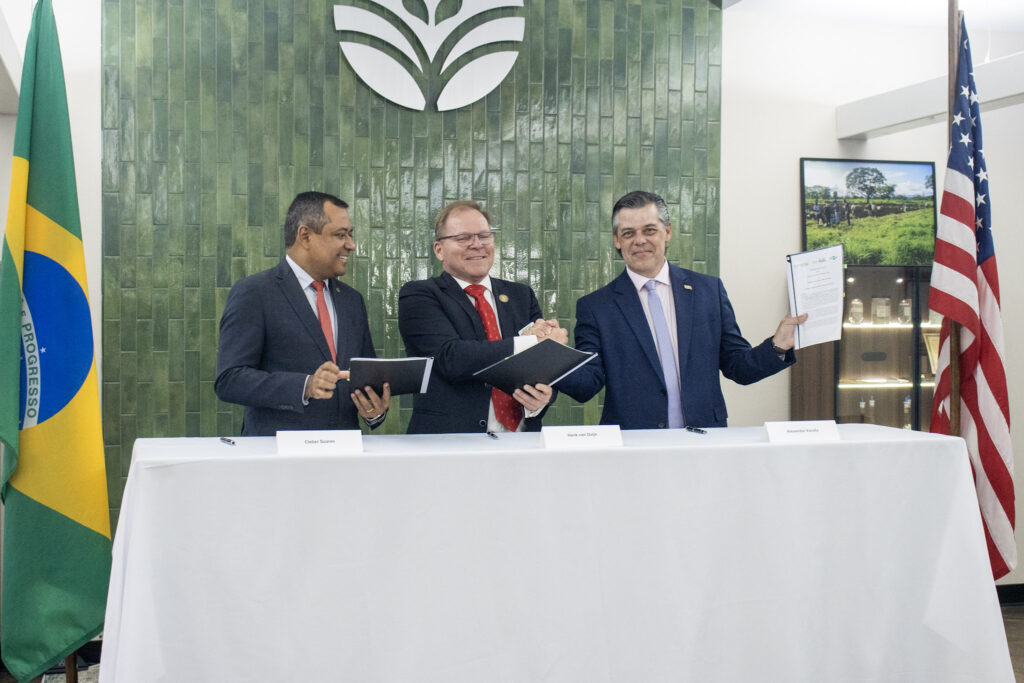
On October 28, a Memorandum of Understanding (MoU) was signed between IFDC, the Ministry of Agriculture and Livestock of Brazil (MAPA), and the Brazilian Agricultural Research Corporation (Embrapa) to advance research and development in sustainable agriculture, food security, and environmental protection.
Expanding IFDC’s global footprint, the organization is establishing new Fertilizer Innovation Centers in key agricultural regions, including Brazil and India. These centers serve as hubs for research, development, and knowledge dissemination, focusing on region-specific challenges and solutions in fertilizer technology and soil health management.
The organization additionally led the launch of the Soil Values program, a 10-year $100 million initiative funded by the Netherlands Directorate-General for International Cooperation (DGIS). The program began its 10-year implementation phase, focusing on improving soil fertility and productive capacity across 2 million hectares of farmland and supporting 1.5 million farmers in the region.
IFDC is also proud to welcome Dr. Zachary P. Stewart as Vice President of Research and Beatrice Bezmalinovic Dhebar as Vice President of Business Development, strengthening our leadership team as we advance innovation and global impact in soil and plant nutrition.
In late 2024, IFDC began an important process to review and reset its organizational strategy, following nearly five years of pursuing a strategy adopted in 2019. The world has changed significantly since then—from shifting climate realities to evolving global food security challenges—and so must we. This strategic renewal is a timely opportunity to adapt and reposition IFDC to remain responsive, impactful, and forward-looking in our mission to build resilient food systems and improve farmer livelihoods around the world.
I extend deep gratitude to the organization’s dedicated staff, whose expertise and passion fuel our mission, and to our partners—governments, donors, research institutions, private sector collaborators, and farming communities—whose commitment and collaboration make our progress possible.
As IFDC’s work continues, the team looks forward to deepening these partnerships, expanding our impact, and pursuing our shared goal of a more food-secure and sustainable world. Together, we are shaping the future of agriculture—one rooted in resilience, innovation, and shared prosperity.
Sincerely,
Neal Gutterson
Chair of the Board of the International Fertilizer Development Center (IFDC)
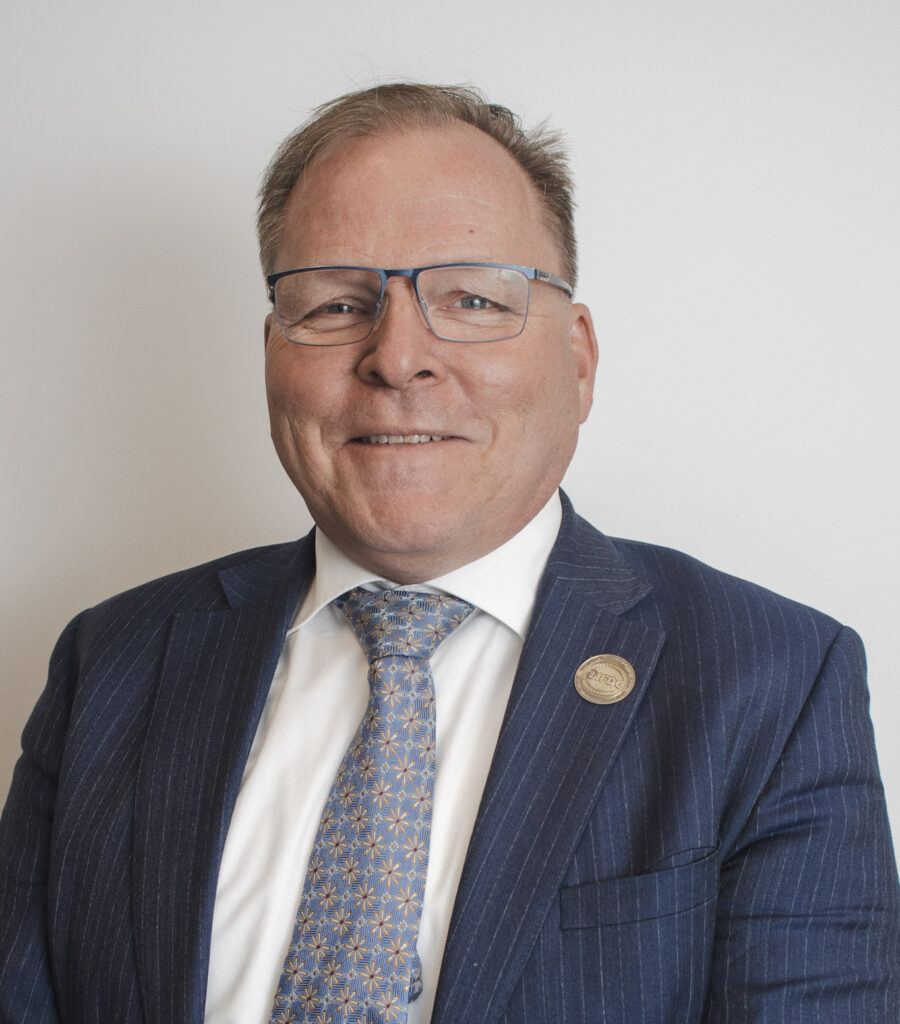
Shaping the Next 50 Years
As we reflect on IFDC’s 50th anniversary in 2024, I am filled with pride and gratitude for the significant progress our organization has made to deliver research, technology, and innovation that empowers smallholder farmers to build sustainable livelihoods worldwide.
IFDC’s journey began in 1974 when U.S. Secretary of State Henry Kissinger addressed the United Nations General Assembly. He called for a global effort to improve agricultural production in developing countries, emphasizing better access to and proper use of advanced fertilizer technologies. IFDC was conceived at the urging of the U.S. Department of State to bridge the gap between scientific research and practical solutions that benefit smallholder farmers.
Building on the legacy of the Tennessee Valley Authority’s National Fertilizer Development Center, IFDC has been at the forefront of developing and disseminating innovative fertilizer technologies and agricultural practices that have transformed the livelihoods of millions of farmers worldwide. Since its inception, IFDC has expanded its reach to over 100 nations and as of 2024 maintains a presence in 31 countries.
Read Henk van Duijn’s letter below
A Letter from the President
Throughout 2024, IFDC strengthened its engagement with global agricultural stakeholders through a series of impactful events and optimistic beginnings.
To honor the organization’s legacy, IFDC hosted Open Door events and successfully held two symposia under the theme “Future Proofing: Unified Action for Soil Health and Food Security,” designed as a dynamic, solution-focused consultation to enhance the conversation in shaping the future of sustainable agriculture.
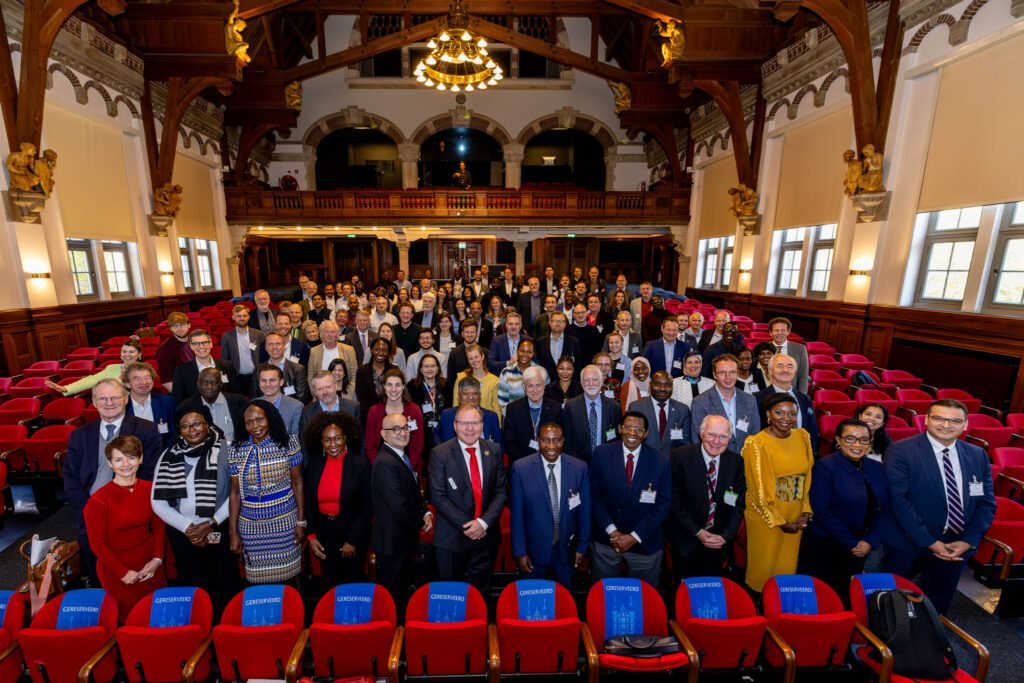
Looking ahead, IFDC is building strong partnerships with government, academia, startups, and private industry across Alabama and the U.S. to grow a robust innovation ecosystem.
These efforts are paving the way for the establishment of a U.S. Fertilizer and Soil Health Innovation Center, with planned locations in Muscle Shoals and Dothan, Alabama.
The Center will serve as a national hub for advancing and scaling next-generation fertilizer technologies that promote sustainable soil health and environmental resilience.
From strengthening partnerships to expanding our presence in the U.S., we’re deepening our commitment to innovation, research, and development where it all began.
IFDC’s 50th anniversary marked a pivotal moment in the organization’s journey, celebrating five decades of transformative contributions to global agriculture. Yet, in looking toward the future, we recognize that progress is not without its challenges.
One such challenge came on February 26, 2025, when IFDC received official notification that all its USAID-funded projects had been terminated as part of a broader policy shift by the Trump administration. This action has had a considerable impact on global development efforts.
While this presents a significant obstacle, IFDC remains steadfast in its vision of producing healthier soils and plants for a food-secure and environmentally sustainable world. We will continue to move forward with our current projects and programs. IFDC’s commitment to soil health, sustainable agriculture, and farmer prosperity has not changed. Working closely with strategic regional partners, the organization will continue to identify and scale the research and innovations that benefit farmers, entrepreneurs, and the environment.
Our dedication to developing agriculture from the ground up remains strong. With gratitude to partners, donors, and the farmers the organization serves, we look forward to another 50 years of agricultural innovation and impact.
With great appreciation,
Henk van Duijn
President and CEO of the International Fertilizer Development Center (IFDC)
Dr. Singh Leaves a Legacy for IFDC Research
Dr. Upendra Singh, who recently retired as Vice President of Research and Chief Scientist at IFDC, leaves behind a legacy spanning more than 30 years of groundbreaking work in soil fertility and systems modeling.
Originally hired for his expertise in phosphate research, Dr. Singh quickly became a foundational member of the IFDC modeling group, expanding his focus to nitrogen dynamics and nutrient use efficiency-areas that would define much of his career.
Read more about Dr. Singh’s legacy below
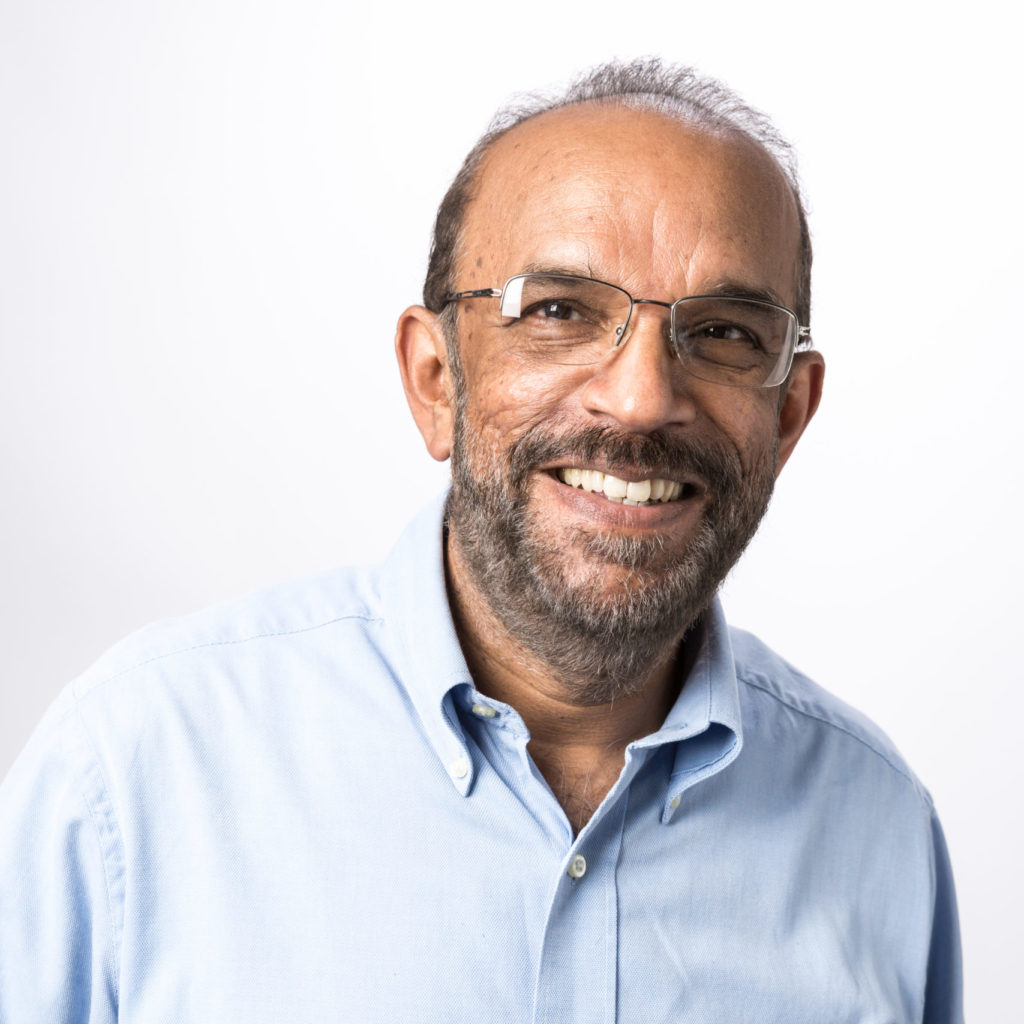
A Tribute to Upendra Singh
Dr. Singh played a pivotal role in developing the Phosphate Rock Decision Support System (PRDSS), a tool that enables researchers and farmers to optimize phosphate fertilizer use based on soil and crop conditions. His expertise extended to developing models for phosphorus, nitrogen, and rice where he collaborated with leading universities–including the University of Florida, University of Hawaii, and University of Michigan–to develop key components of nitrogen models for the widely used Decision Support System for Agrotechnology Transfer (DSSAT).
These models have improved understanding of phosphorus and nitrogen uptake and synchronization with crop demand, helping to reduce nutrient losses and enhance yields.
Beyond his research, Dr. Singh was instrumental in organizing and conducting international training programs on integrated soil fertility management (ISFM), fertilizer research, and crop modeling, sharing his knowledge with students, scientists, and practitioners worldwide.
He hosted and led numerous DSSAT development sprints and workshops, fostering collaboration among global experts and advancing the science of crop simulation and decision support tools.
As IFDC appoints new leadership, the organization bids a heartfelt farewell to Dr. Singh as he embarks on a new journey. His departure closes a significant chapter defined by scientific rigor, innovation, and dedication to improving soil fertility and agricultural productivity.
Now, as Dr. Zachary Stewart steps into the role of Vice President of Research, IFDC will build on Dr. Singhs’ impactful legacy and continue to deepen its commitment to farmer-centric research, adapting to the rapidly evolving needs of local agriculture.
For these years to come, the organization looks ahead in innovation and does so with gratitude for the foundation laid and great optimism for what lies ahead.
IFDC Appoints New Leadership
IFDC welcomed two new Vice Presidents to the leadership team, bringing with them a wealth of experience and strategic insight. With their leadership, we are enhancing our capacity to deliver innovative solutions, scale successful models, and respond more effectively to the evolving challenges of global food security.
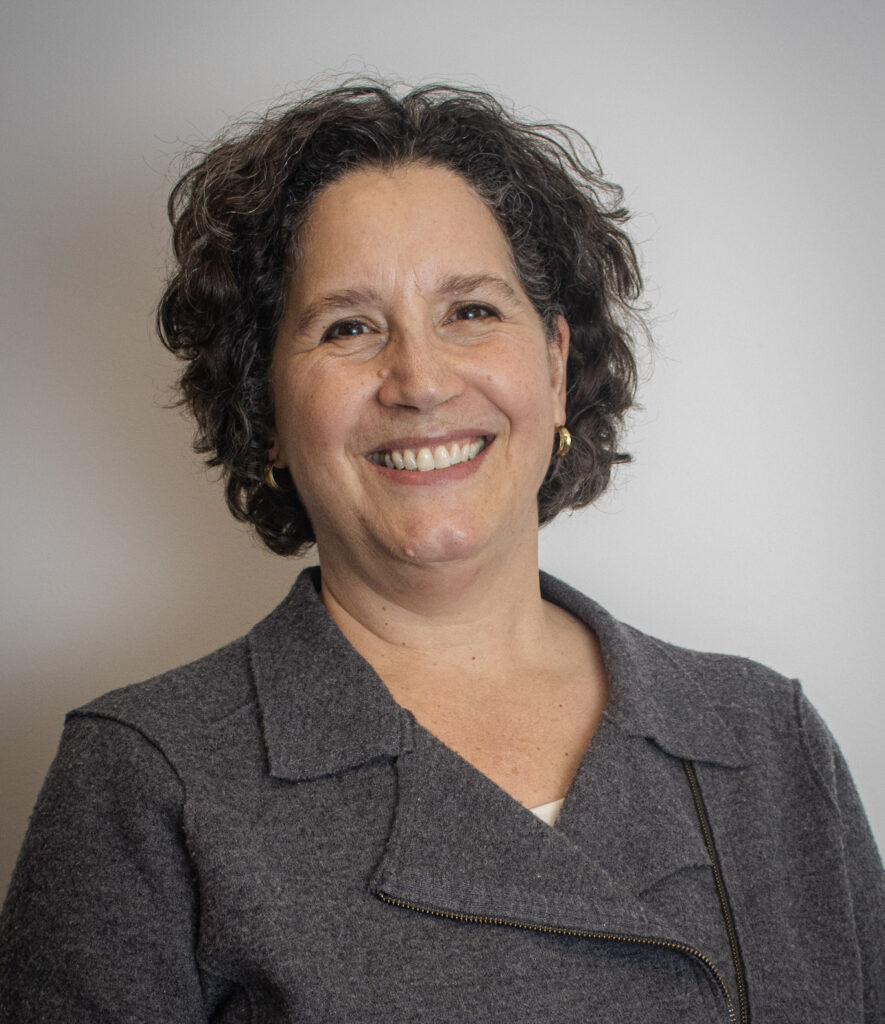
Beatrice Bezmalinovic Dhebar
Beatrice Bezmalinovic Dhebar joins the organization to lead its business development team. With more than 25 years of experience in global health and development, Bezmalinovic Dhebar is highly experienced in business development, project management, and consultancy, with a strong track record of driving results and delivering strategic solutions.
Her career reflects her passion for leveraging business development to foster links between strategy, implementation, and impact. She has successfully engaged with diverse funders, including the United States Agency for International Development (USAID), the Gates Foundation, United Nations agencies, and European donors.
Dr. Zachary P. Stewart
Dr. Zachary P. Stewart joins IFDC as the organization’s new Vice President of Research and Chief Scientist. Dr. Stewart brings significant expertise in international agricultural research and development and a multidisciplinary background that will be invaluable in his new role.
As Senior Food Security Advisor at USAID, Dr. Stewart led transformative initiatives aimed at enhancing global food and nutrition security for smallholder farmers across sub-Saharan Africa and Southeast Asia. His efforts not only served to increase agricultural productivity but also led to improve livelihoods and nutrition for farming communities worldwide.
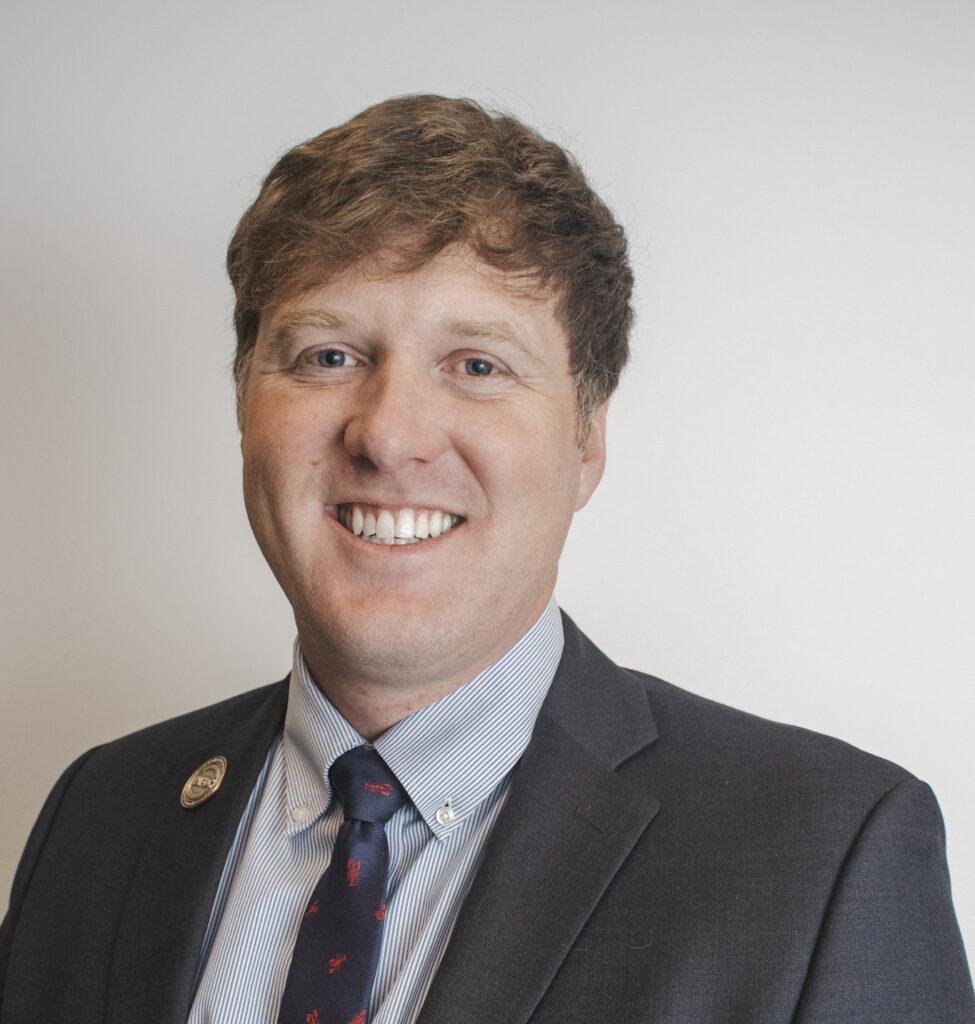
A Global Celebration of Impact, Innovation, and Commitment
What began as a singular mission to advance fertilizer development has since grown into a movement seeking to achieve soil health, food security, and sustainable agriculture worldwide.
To honor this 50-year legacy, IFDC staged a year-long celebration in 2024 that included 13 Open Door events across its country offices as well as two landmark symposia in Washington, D.C., and Amsterdam.
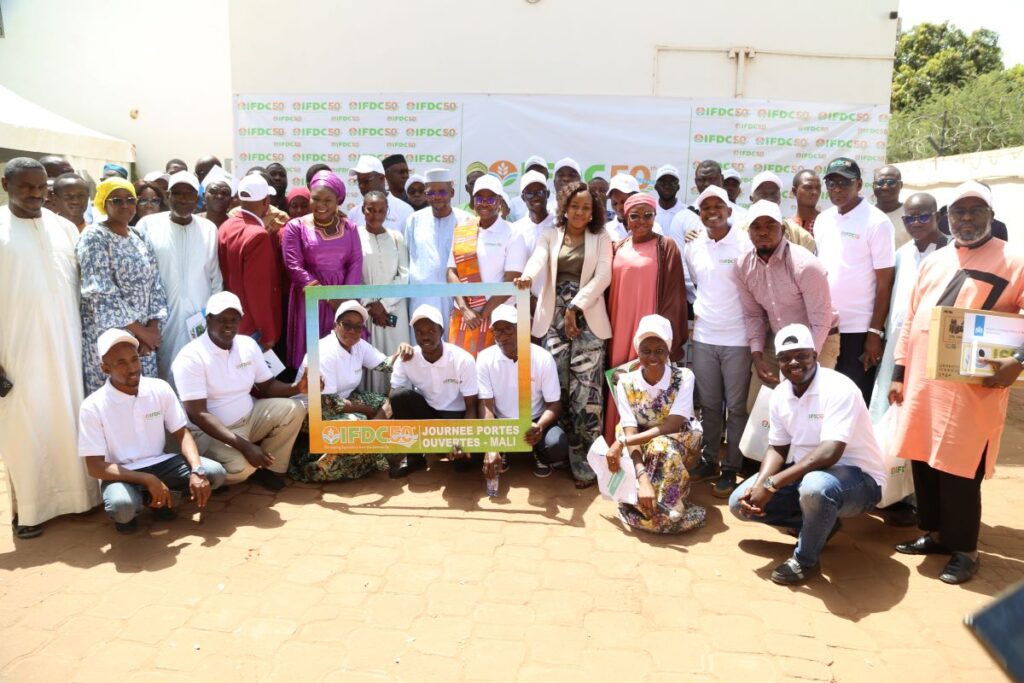
The Open Doors welcomed nearly 1,300 guests, including representatives from government ministries, international organizations, donors, research institutions, and local entities, amplifying the conversation around soil health and food security on a global scale.
These local events served to reaffirm IFDC’s vital partnerships with national governments and international development agencies and paved the way for continued progress toward resilient food systems.
Oumar Tamboura, representing Mali’s Ministry of Agriculture, spoke about the enduring collaboration between IFDC and the Government of Mali. He noted, “I remain convinced that IFDC’s reiterated commitment to providing innovative solutions to meet challenges linked to fertilizers and soil health will not be in vain and that together we will succeed in achieving our objectives.”
This sentiment was echoed in Benin by Dr. Dossa Aguemon, Director of Cabinet at the Ministry of Agriculture, Livestock and Fisheries, who declared government support for IFDC. He stated, “I would like to reassure IFDC, its technical and financial partners, and the various actors involved of the support of the Government of Benin, which will spare no effort to assist you in your noble task of sustainable agricultural development in Benin.”
A highlight of this anniversary year was the IFDC symposia, “Future Proofing: Unified Action for Soil Health and Food Security,” held in Washington, D.C., and in Amsterdam, the Netherlands. The symposia employed a hybrid model to convene nearly 300 high-level guests from government agencies, the private sector, international development organizations, universities, and research institutions, as well as representatives of international financial institutions and embassies.

Designed as a dynamic, solution-focused consultation, the symposia showcased IFDC’s role as a thought leader in soil health and sustainable agriculture.
Five working groups were established for the symposia, designed to spark cross-sector collaboration and drive actionable solutions. Organized by key sectors, these groups engaged in dynamic discussions to strengthen soil health and food security in Africa.
Participants emphasized the importance of public-private partnerships, enhanced access to soil data, youth engagement, and policy alignment to scale impact across regions.
As the global population continues to rise, these discussions will remain crucial in shaping the future of sustainable agriculture.
“Africa will be the next breadbasket of the world,” said Dr. Rattan Lal, Distinguished Professor of Soil Science and Director of the College of Food, Agricultural, and Environmental Sciences at The Ohio State University. “It has the soils, the resources, the climate, and the people. What we need is for the policymakers to put word[s] into action.”
Commemorating 50 years of IFDC’s agricultural innovation and partnerships, the Open Doors and symposia were more than just a time for celebration – they marked the organization’s recommitment to its mission. Leaders, partners, and stakeholders gathered not only to reflect on past achievements but also to chart the course ahead.
By building on five decades of impact and leveraging the insights and alliances forged during this anniversary year, IFDC is poised to help shape the next era of resilient, sustainable food systems.
50 Years of Impact
IFDC Results
Our Reach in 2024
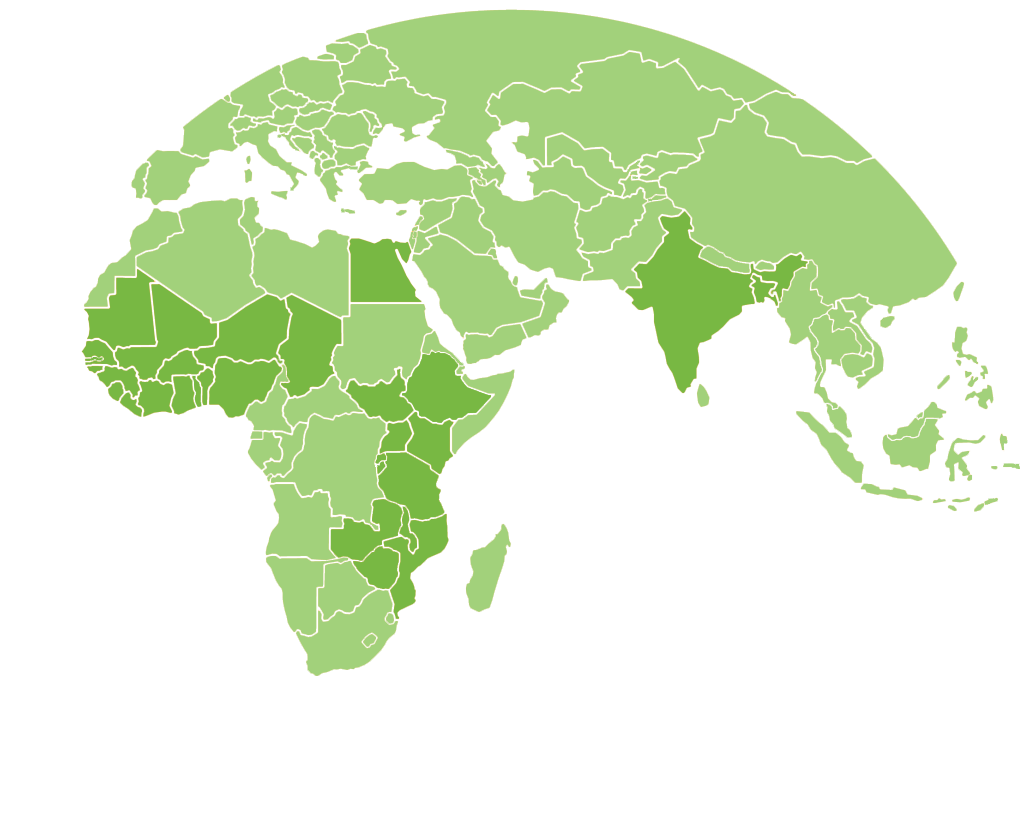
Key Indicators
Measuring Impact 2020-2024
| Indicators | 2020 | 2021 | 2022 | 2023 | 2024 | |||||
|---|---|---|---|---|---|---|---|---|---|---|
| Total | Projects | Total | Projects | Total | Projects | Total | Projects | Total | Projects | |
| Hectares under improved technologies | 193,768 | 17 | 419,652 | 13 | 641,595 | 11 | 821,907 | 20 | 509,515 | 15 |
| Farmer participants who applied technologies | 416,522 | 18 | 527,003 | 11 | 945,930 | 11 | 650,917 | 20 | 432,986 | 16 |
| Farmers trained (% women) | 267,023 (46%) | 18 | 408,557 (53.4%) | 14 | 258,566 (47%) | 14 (13) | 464,097 (38%) | 22 (22) | 374,402 (54%) | 16 |
| Demonstration plots established | 14,501 | 20 | 9,383 | 14 | 5,661 | 11 | 7,564 | 17 | 9,566 | 15 |
| Public-private partnerships formed | 838 | 24 | 245 | 14 | 331 | 12 | 424 | 21 | 400 | 15 |
| Outreach activities | 5,133 | 25 | 4,054 | 15 | 5,083 | 16 | 4,887 | 20 | 4,860 | 12 |
| Climate-adaptive technologies (hectares)* | 302,482 | 3 | 428,122 | 8 | 549,407 | 13 | 173,887 | 13 | ||
| Private agri-enterprises that have benefited or improved as a result of interventions* | 8,376 | 6 | 7,152 | 7 | 4,956 | 12 | 1,676 | 11 | ||
| New jobs created as a result of agribusiness interventions* | 14,242 | 3 | 22,316 | 2 | 7,141 | 1 | 21,070 | 9 | ||
| *New indicators as of 2021 |
Impact Assessment
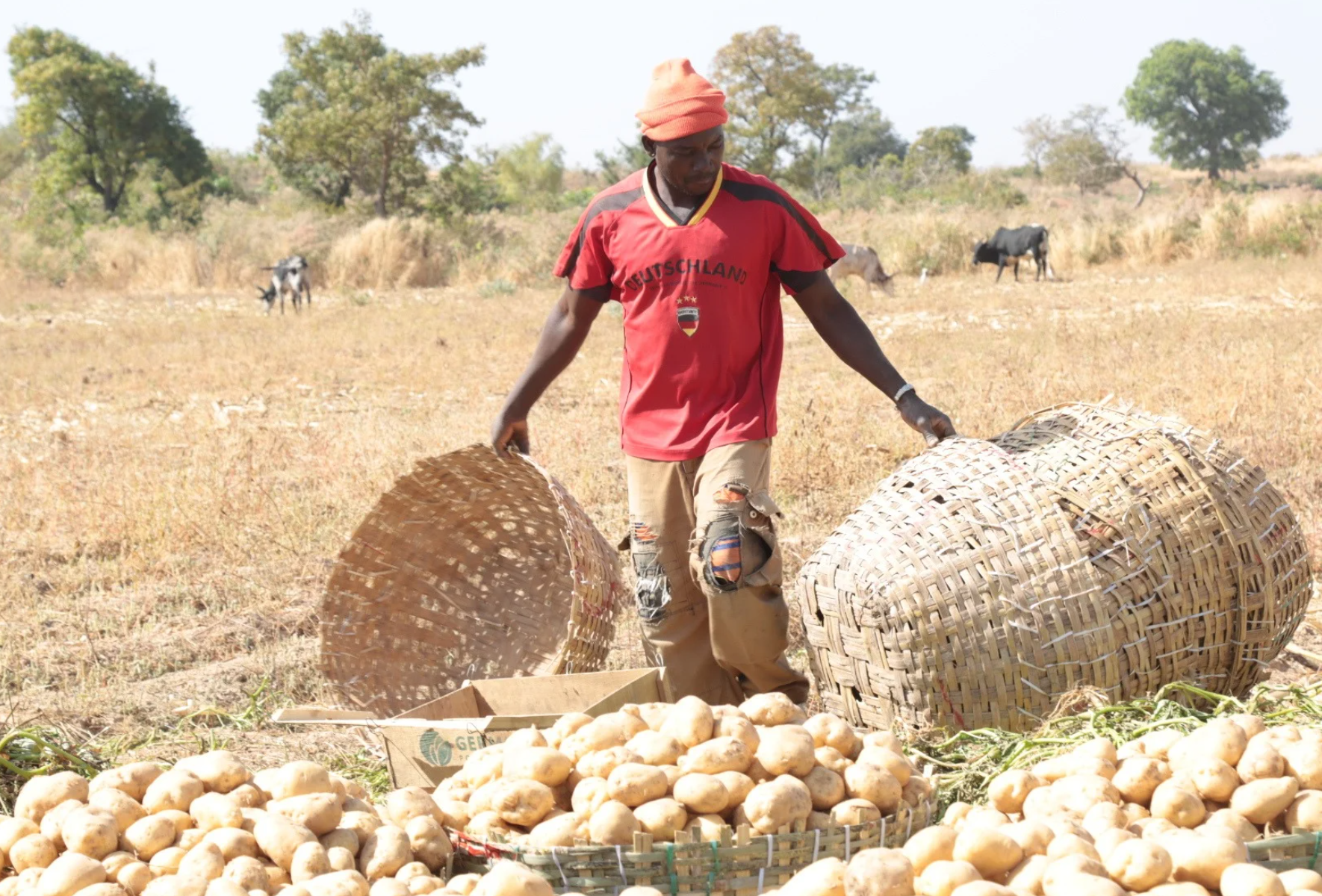
IFDC seeks to measure the success of program interventions not only through the number of agricultural and soil health innovations the organization has developed or the large number of beneficiaries reached but, ultimately, by the actual advances in soil health the organization has achieved and the real improvements made in the livelihoods of program beneficiaries.
This assessment aims to measure the effects and impacts of IFDC’s interventions by leveraging available datasets from both past and ongoing projects. The assessment is informed by key performance indicators, including the farm-level profitability of soil health improvement technologies and global program interventions on soil health, crop yields, poverty reduction, and food and nutrition security.
This initial report presents evidence from projects with readily available practical data. The overall aim is to assess all IFDC programs, and this activity will be expanded to include other projects. The present assessment considered the impacts of various program interventions on soil health, crop yield, income, food security, and gender gaps.
Interventions Implemented by the Programs Assessed
The following interventions were implemented by the programs in 2024:
- The Soil Fertility Stewardship Project (PAGRIS) based its actions on two complementary strategic approaches: integrated soil fertility management (ISFM) and integrated farm planning (PIP). Interventions included the promotion of improved sustainable land conservation management techniques, climate-resilient strategies, and dolomite fertilizers.
- The Fertilizer Research and Responsible Implementation (FERARI) program experimented with innovative fertilizer recommendations combined with best agronomic practices, such as the use of improved seeds and farm management, in Ghana. Interventions included farmer education on best practices and extension service support.
- The Communal Approach to the Agricultural Market in Benin – Phase 3 (ACMA3) program promoted the development of agricultural market linkages, value chain activities, and technical training. The program supported access to inputs, microcredit, and digital tools for farmers and promoted climate-smart agriculture.
- The Feed the Future Bangladesh Climate Smart Agriculture (CSA) Activity strengthened seed systems to increase the availability of climate-adapted varieties, improved private sector capacity to distribute high-quality agricultural inputs and link smallholder farmers to output markets, and expanded farmers’ access to climate-smart technologies and practices through training, advisory services, and digital tools.
Impact of Interventions
On Soil Health
Restoration, improvement, and maintenance of soil health are critical aspects of IFDC’s institutional goals. In line with this, PAGRIS seeks to achieve ecologically sustainable land management and improve the acidity of the soils in Burundi by introducing dolomite technology.
This strategy has had a significant impact on soil pH, correcting the acidity level for most parts of the country by up to about 10%. Considering the significant role of soil pH in driving most soil properties, the change in soil pH due to PAGRIS’s interventions will result in overall improvement in soil health, fertilizer use efficiency, and crop yields.

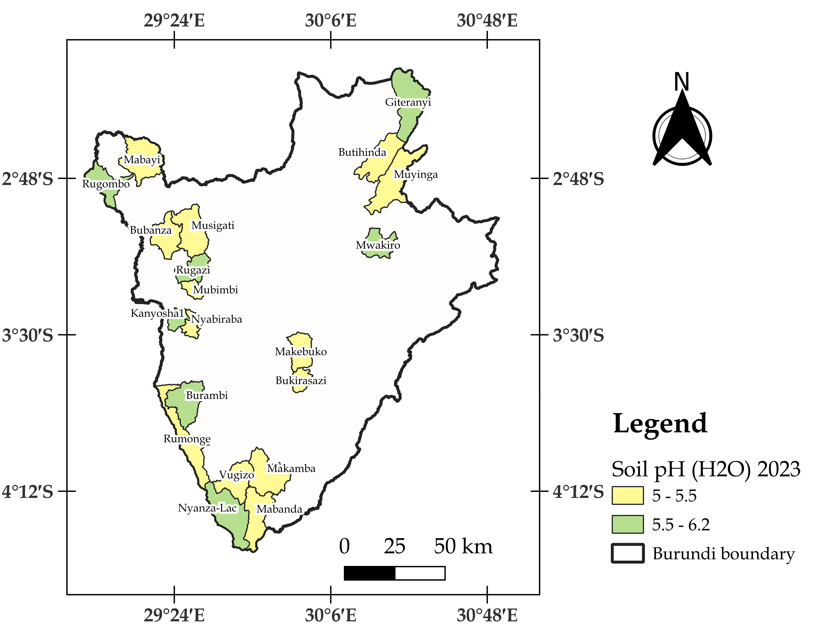
On Crop Yield
One of IFDC’s fundamental objectives is to improve crop yields at farm level. Its programs have achieved this objective at varying degrees for different crops (Table 1). Although yields remain low for most crops, the impact of IFDC’s interventions has been significant, ranging from 27% to 300% growth, which could potentially improve food availability.
Table 1. Impact of IFDC’s interventions on crop yields
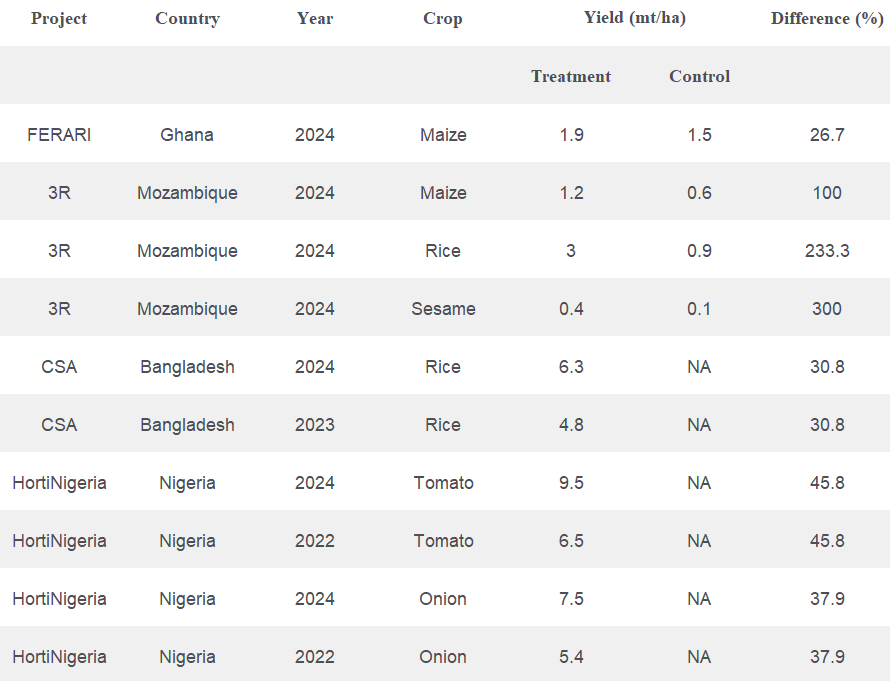
On Income and Poverty

One of IFDC’s fundamental objectives is to improve crop yields at farm level. Its programs have achieved this objective at varying degrees for different crops (Table 1). Although yields remain low for most crops, the impact of IFDC’s interventions has been significant, ranging from 27% to 300% growth, which could potentially improve food availability.
Income Improvement
IFDC project beneficiaries experienced income increases ranging from 6% to 197% compared to nearby non-beneficiaries. For example, ACMA3 led to income increases of 7% in 2023 and 10% in 2024, while PAGRIS beneficiaries saw a 17% increase. Beneficiaries of FERARI and 3R also earned more than non-beneficiaries. Similarly, farm incomes under CSA and HortiNigeria improved over time, even after adjusting for price changes.
Poverty Reduction
IFDC project beneficiaries consistently earned greater incomes above the extreme poverty line of $2.15/day, compared to non-beneficiaries. For example, total income of ACMA3 and PAGRIS beneficiaries was 327% and 22% above the poverty line, compared to 287% and just 4% for non-beneficiaries. With FERARI, farm income for beneficiaries was 5% above the line, while non-beneficiaries fell 7% below the poverty line. For the 3R program, both groups were below the threshold, but beneficiaries fared significantly better (28% below vs. 76% below).
Table 2. Impact of IFDC’s interventions on income and poverty reduction
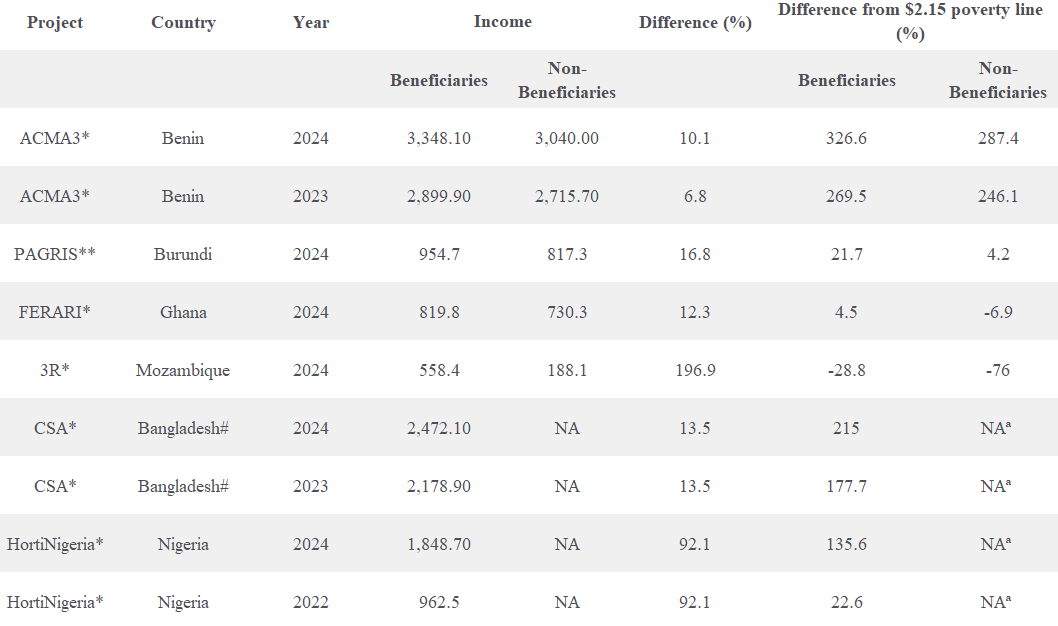
On Gender Yield and Income Gaps
Gender-focused interventions proved effective: in HortiNigeria, female farmers out-yielded male peers in every crop except pepper—by 23% in tomato, 16% in onion, and 5% in rice—showing women’s strong productivity potential.
The ACMA3 project showed female beneficiaries earned 55% more than males. In HortiNigeria, women earned 27% more per hectare of tomato, though men still had higher incomes from pepper and onion.
Table 3. Impact of interventions on gender yield and income gap
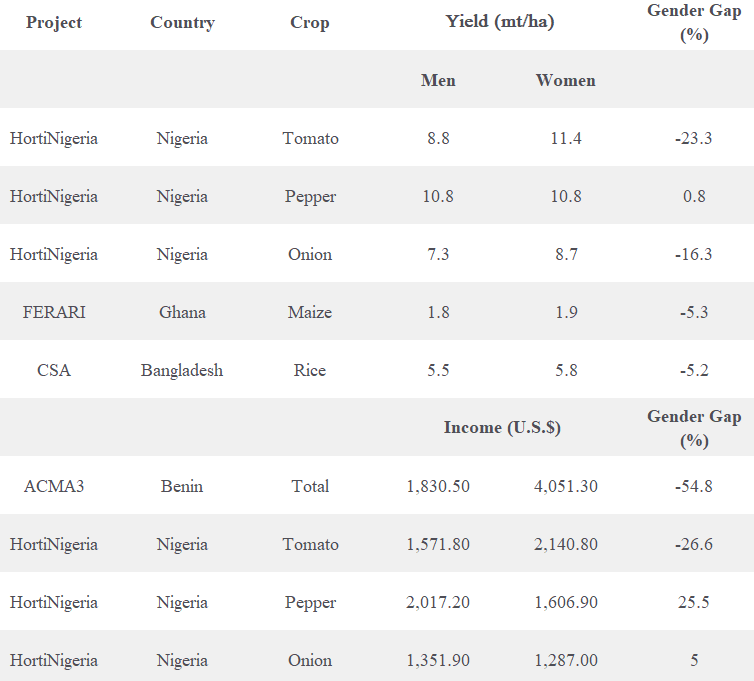
On Food Security

Improvements in yields and incomes are thought to be associated with improved food security. However, the evidence showed that the food security gains from IFDC’s interventions were marginal (Table 4).
Project beneficiaries generally had a Food Consumption Score (FCS) almost 4% above that of non-beneficiary households, while the FCS of ACMA3 program beneficiaries was nearly 3% lower than that of non-beneficiaries. This critical lesson highlights the need for programs to ensure that improvement is made in food security.
Table 4. Impact of IFDC’s interventions on household food security, 2024

Innovations and Research Department
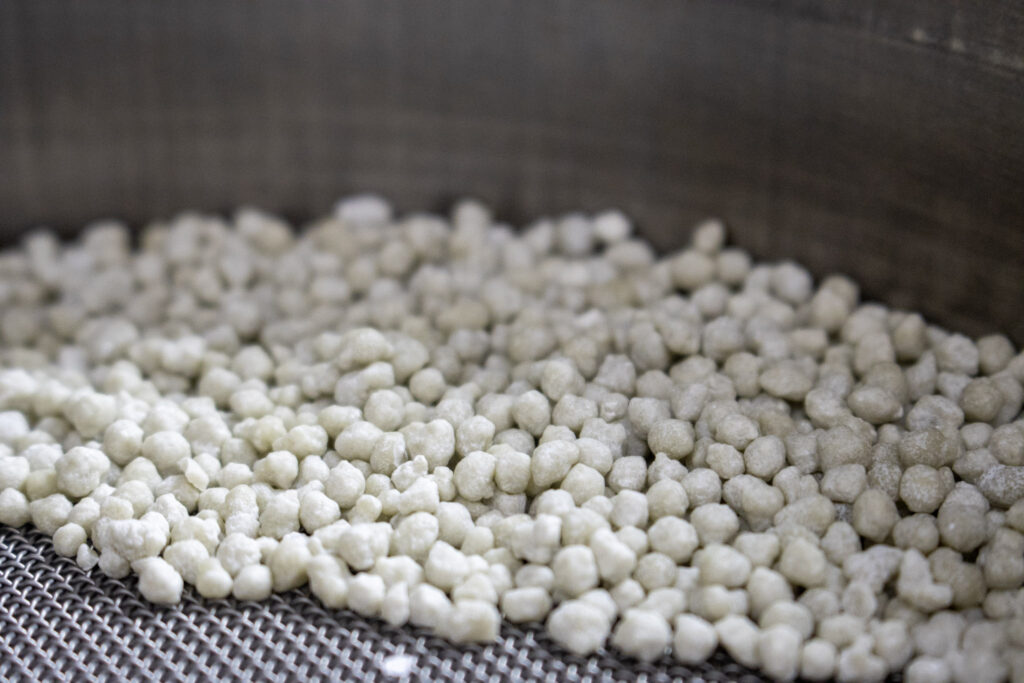
In 2024, the Innovations and Research Department secured funding for nine projects, valued at U.S. $4 million. One important initiative is the Green Ammonia project, which focuses on developing prototype formulations by capturing and converting green ammonia into slow-release fertilizers. The project aims to address rising fertilizer costs and environmental concerns, particularly in sub-Saharan Africa, through a systematic evaluation of nutrient-release dynamics, transformations, and agronomic performance.
During the year, the department led 13 research projects spanning diverse innovations in fertilizer development and sustainable soil management. These included the characterization and evaluation of organo-mineral fertilizers, novel potassium sources, enhanced efficiency nitrogen fertilizers, and carbon capture technologies. Key areas of investigation included tailoring phosphate rock for direct application, assessing the potential of biochar as a soil amendment, and developing micronutrient-enriched fertilizers containing boron, molybdenum, and copper.
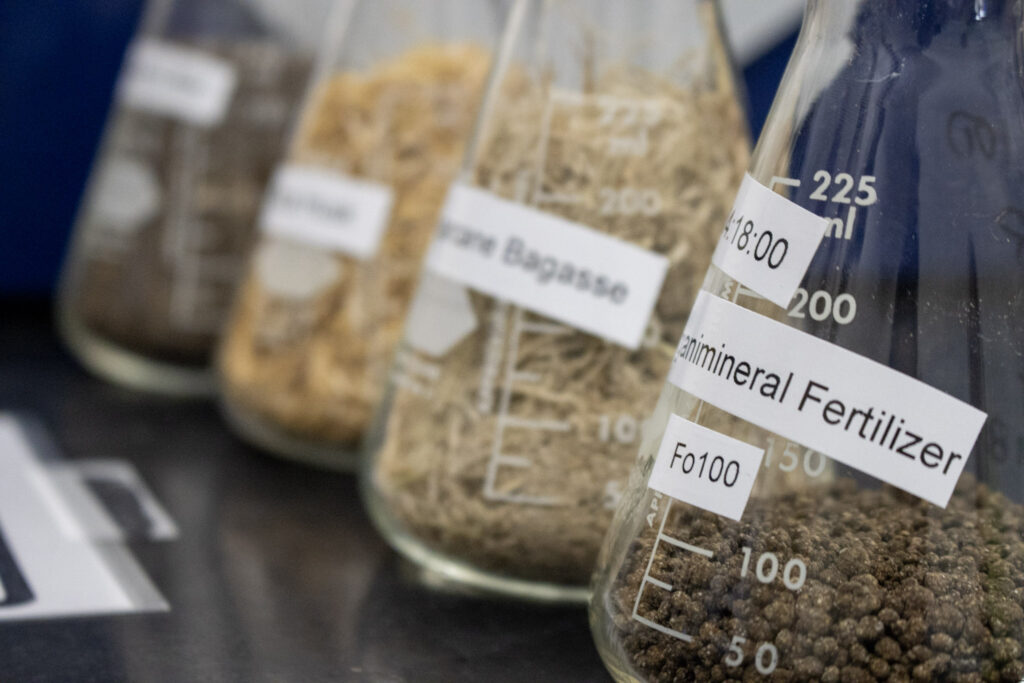
Additional studies addressed the water requirements for salts leaching into sodic soils using new fertilizer inputs and evaluated volatilization and leaching losses of new fertilizer types. The department also delivered training on ammonia volatilization research for a leading fertilizer manufacturer, supported greenhouse gas monitoring for a climate-smart agriculture project in Bangladesh, and assessed the agronomic effectiveness of nitrogen and phosphorus-based enhanced efficiency fertilizers through greenhouse trials.
In 2024, the Innovations and Research team contributed to five peer-reviewed publications and delivered seven presentations at international conferences. The department also submitted 12 research reports to various funding and implementing agencies and successfully organized four scientific events.
Pilot Plant
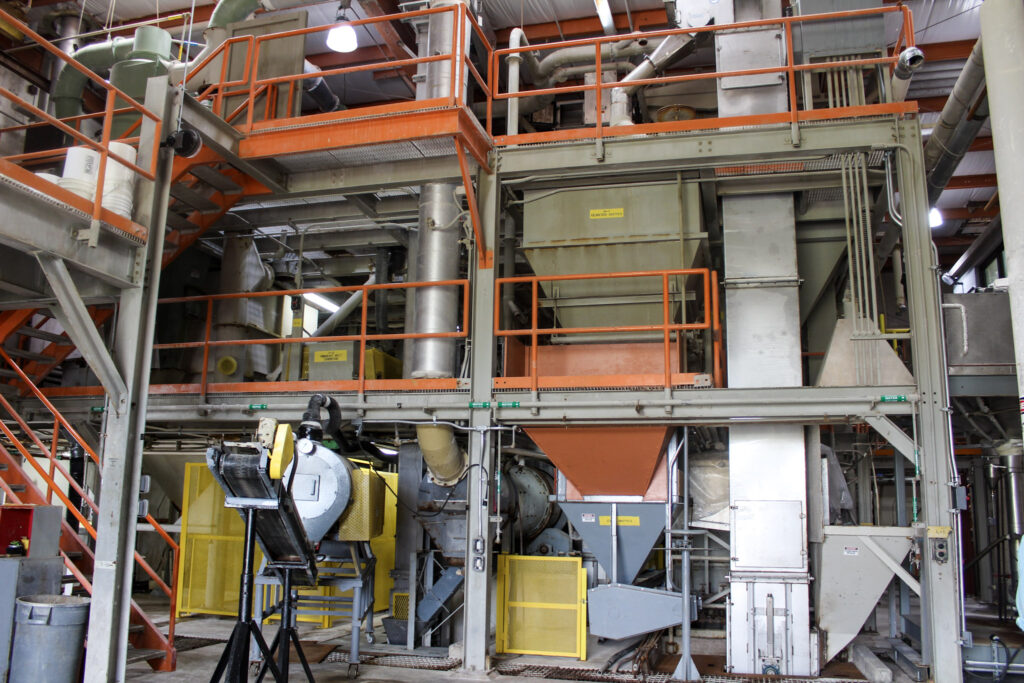
The Engineering and Pilot Plant Department completed 13 projects for seven different industry partners in 2024. These projects included:
- Pilot plant activities
- Production of 15 metric tons (mt) of controlled-release fertilizers of various formulations.
- Granulation of controlled-release phosphate-based fertilizers of various formulations.
- Incorporation of soil amendment additives into phosphate-based fertilizers.
- Processing and concentration of 1 mt of wet-process phosphoric acid.
- Product characterization/evaluation
- Various product characterizations and physical properties testing for multiple customers to evaluate handling and storage characteristics, dustiness, and the effects of additives.
- Engineering
- Front-end engineering design for a commercial-scale facility to produce controlled-release nitrogen fertilizers.
The pilot plant resumed operations in July 2024 after being going through several months of renovations and upgrades, including concrete repairs. Some renovations will continue into the future.
SOILS-Space to Place (SOILS-S2P)
Funded by USAID and implemented by IFDC from 2022 to 2025, the Sustainable Opportunities for Improving Livelihoods with Soils (SOILS)-Space to Place (S2P) initiative provided hyperlocalized soil nutrient recommendations in sub-Saharan Africa.
The program combined soil maps (“Space”) with farm-level characteristics (“Place”) to optimize fertilizer use efficiency and economic returns. The S2P initiative applied a comprehensive approach to enhancing soil fertility management across sub-Saharan Africa through three interconnected levels of impact.
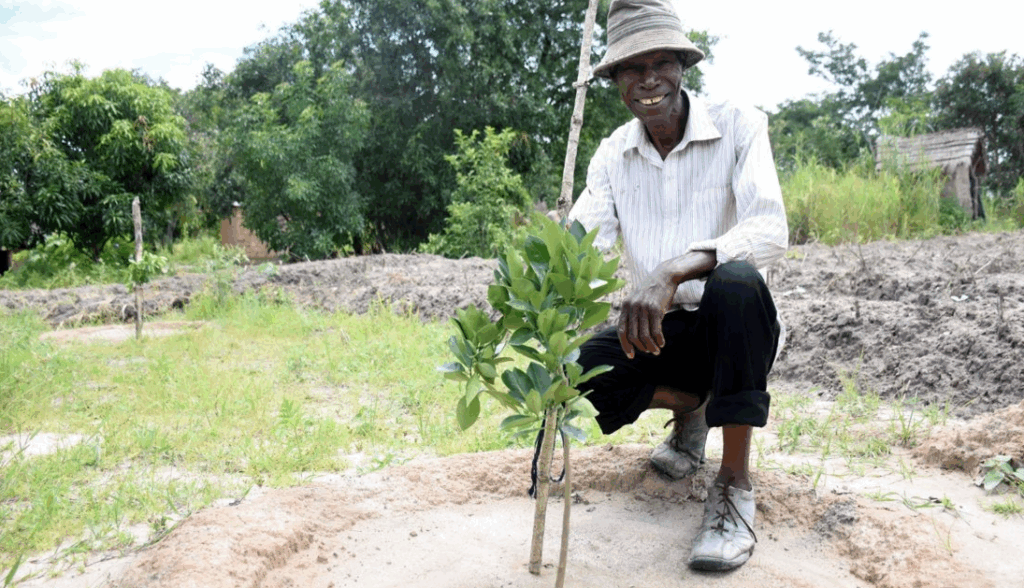
1. Scaling Proven Technologies
S2P generated rapid impact through the swift scaling of proven soil fertility technologies.
Partnering with established scaling networks, the initiative successfully integrated soil health practices into existing agricultural systems across Ghana, Malawi, Tanzania, and Zambia, creating pathways for rapid adoption and achievement of tangible outcomes.
Key achievements in 2024 included reaching 350,000 smallholder farmers and building the capacity of 2,000 last-mile input providers on soil health and balanced fertilizer management practices across Ghana, Madagascar, Malawi, Niger, Tanzania, and Zambia in collaboration with the Accelerated Innovation Delivery Initiative (AID-I), led by the International Maize and Wheat Improvement Center (CIMMYT).
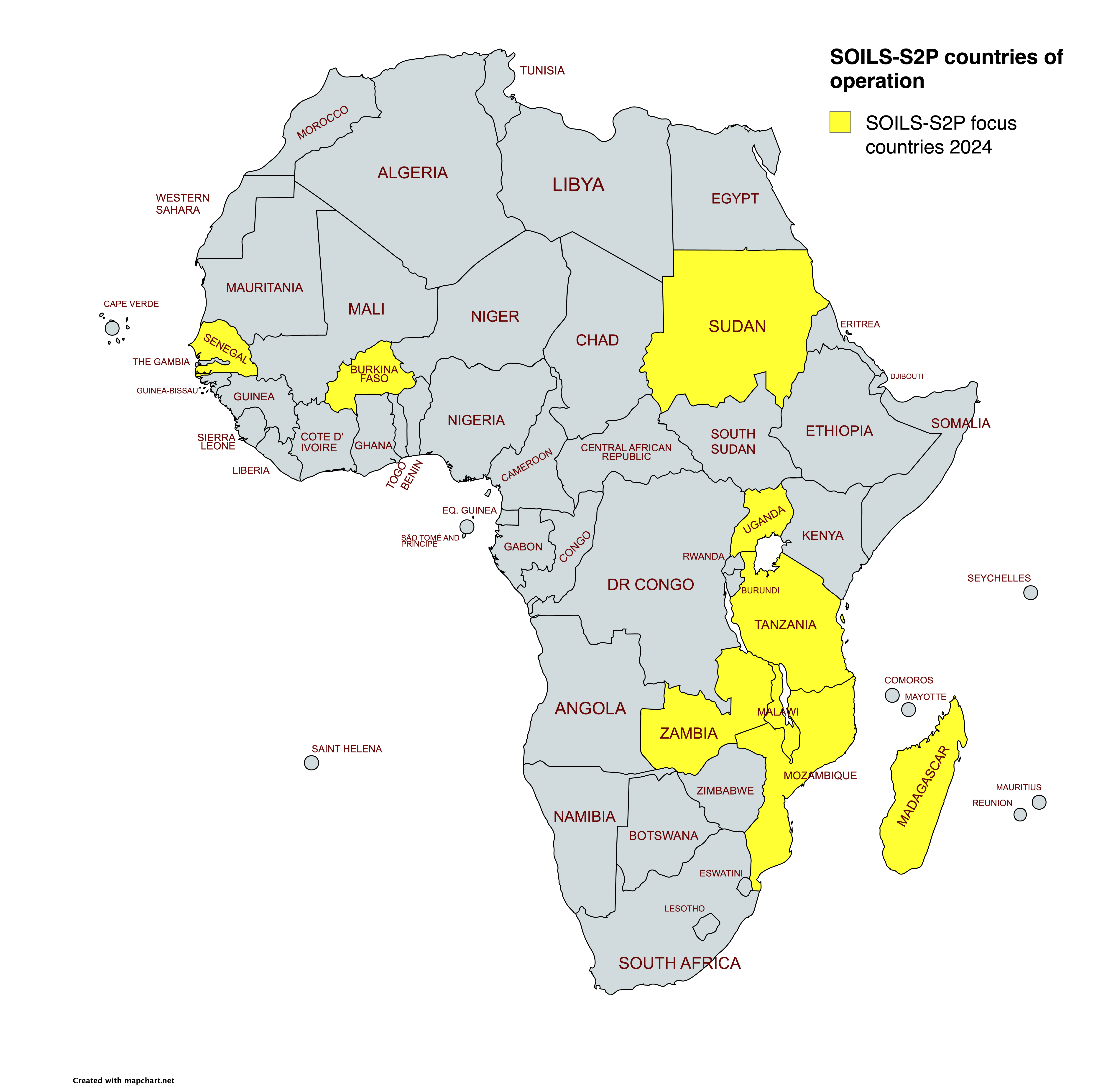
Working with One Acre Fund, S2P widened its coverage in Zambia to integrate demand-driven soil health practices with the following objectives:
Strengthen food security through increased crop production
- Expanded to reach 20,000 households.
- Delivered training on optimal, balanced fertilization.
- Brokered credit and financing.
Build farmer resilience and soil health by scaling agroforestry
- Provided nitrogen-fixing tree packages to farmers to build multiple layers of resilience in farming for soil health through nitrogen fixation.
- Facilitated regular income generation through harvests of fruit and medicinal trees.
- Promoted carbon credit financing.
2. Improving Impact at Scale
To improve impact at scale, S2P’s activities addressed critical data gaps in major cropping systems to enhance the quality of information on soil fertility through its decision support system (DSS).
The DSS integrates soil maps and geographic information with new crop response data and farmer input to deliver precise soil health guidance for smallholder farmers. The S2P DSS also enables more profitable and productive fertilizer use through extension partners across sub-Saharan Africa.
During the 2023‑24 season, S2P partnered with national agricultural research systems, the private sector, and farmers to establish 2,200 field-based demonstrations across diverse cropping systems in six countries of sub-Saharan Africa, focusing on optimization of fertilizer and soil management practices across 27 agroecological zones for 15 crops.
These demonstrations assessed various treatment combinations to identify nutrient deficiencies and determine the best fertilizer application rates for improved yields and farm income. At least 30 fertilizer trials were conducted per crop in each agroecological zone.
An analysis of maize in Uganda revealed variable nutrient responses across farms. Nitrogen and phosphorus were identified as the most limiting nutrients for upland rice, maize, bean, Irish potato, and sunflower, while a positive response to potassium and secondary and micronutrients was observed in only a few locations.
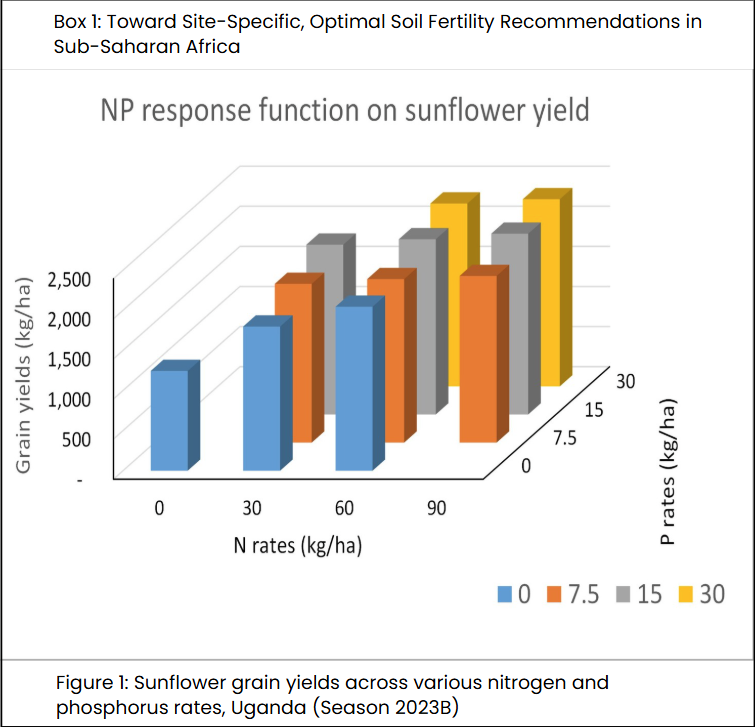
The effectiveness of nitrogen was influenced by phosphorus and potassium application, particularly for maize. For most crops, nitrogen application beyond 60‑90 kilograms per hectare showed no significant yield improvement.
GSSAT2, an interactive geospatial crop modeling and decision support tool, enhances the existing capabilities of the Decision Support System for Agrotechnology Transfer (DSSAT) platform by transforming it from point-based to spatial crop simulation, enabling localized soil fertility recommendations.
In 2024, GSSAT2 models, calibrated using legacy data, SoilGrids, and NASA Prediction of Worldwide Energy Resources (POWER) weather information, determined the optimal planting period of popular maize varieties for Madagascar, Malawi, Tanzania, Uganda, and Zambia.
Further analyses revealed significant spatial variability in maize yield potential, with notable gaps due to water in western Zambia and eastern Tanzania, while gaps due to nutrients were consistently wider across all regions.
These findings confirm that location-specific fertilizer recommendations are essential for optimizing nutrient use efficiency and productivity, as opposed to conventional blanket approaches.
GSSAT2 provides a promising framework for developing tailored recommendations to improve agricultural sustainability in sub-Saharan Africa.

3. Championing Sustained Impact

S2P championed sustained impact by elevating soil fertility management to continental policy level through support for action plans endorsed and outlined at the Africa Fertilizer and Soil Health (AFSH) Summit in May 2024 and coordination mechanisms at pan-African, regional, and national levels through the Soil Initiative for Africa (SIA), thus fostering systemic change and lasting transformation in African agricultural systems.
The S2P approach has also been recognized in the African Union’s soil health implementation plans as a pathway from blanket to optimized recommendations.
Fertilizer Research and Responsible Implementation (FERARI)
Ghana (2019-2024) | Budget: U.S. $7.1 million | Donors: Mohammed VI Polytechnic University (UM6P), OCP, and institutional contributions
Implementing Partners: Mohammed VI Polytechnic University (UM6P), OCP, Wageningen University & Research (WUR), University of Liège, University of Ghana, Kwame Nkrumah University of Science and Technology, University for Development Studies, University of Energy and Natural Resources, Akenten Appiah-Menka University of Skills Training and Entrepreneurial Development, Ministry of Food and Agriculture (Ghana), and research institutes of the Council for Scientific and Industrial Research

FERARI was an international public-private partnership that advanced science-based, site-specific fertilization approaches for improved food and nutrition security in Ghana. Over five years, FERARI demonstrated how research can inform on-the-ground implementation.
Moreover, the program supported the creation of the Fertilizer Platform Ghana (FPG) to align public and private sector efforts. FERARI conducted over 600 fertilizer response trials for maize, rice, and soybean, engaging more than 2,400 farmers and 30 extension officers.
Though not directly focused on farmer outreach, participants in the program’s demonstration plots saw yield increases of 20% or more and improvement in fertilizer use efficiency of more than 100%, contributing to a rise in household food security.
FERARI collaborated with seven Ghanaian universities and two national research institutes to train over 50 Ghanaian students, 13 African master’s students, and six Ghanaian doctoral students. The program also helped launch a Fertilizer Science and Soil Health master’s program and an International Modeling and Mapping Center at the University of Cape Coast.
By developing advanced fertilizer recommendation models, including a site-specific 70:50:50+20S NPK formula for maize, FERARI delivered measurable agronomic and economic benefits and actively engaged policymakers, donors, and the scientific community.
Further information, including newsletters, research reports, policy briefs, and scientific publications, can be found at https://ifdc.org/projects/fertilizer-research-and-responsible-implementation-ferari/.

Catalyze Farm Productivity
The Soil Health Systems and Agricultural Productivity Department at IFDC has integrated soil health into market-oriented value chains, emphasizing grassroots-level participation of farming households in the selection and application of agroecologically adapted soil health solutions to sustainably boost productivity while safeguarding the environment.
Swipe or use keyboard arrows to navigate. Click project for more info.
Focus on Success: Triple Resilience (3R)
Market Systems Development
Through strategic partnerships and innovative strategies, IFDC has effectively merged research insights on soil health with our market systems development (MSD) initiatives, bolstering the resilience and productivity of farming systems.
By embedding soil health management practices into market-oriented agricultural value chains, IFDC promotes sustainable production and empowers smallholder farmers, particularly women and youth, to thrive in dynamic markets. This integration has yielded tangible outcomes, such as increased yields, enhanced soil fertility, and improved market access, advancing broader agricultural development objectives.
Swipe or use keyboard arrows to navigate. Click project for more info.
Focus on Success: HortiNigeria
Enabling Impact
One of the four pillars of IFDC’s work is to enable impact. Through its project interventions, IFDC seeks to create a favorable environment for making profitable investments in fertilizer and soil health and aims to sustainably increase agricultural productivity.
Achieving these goals will translate to efficient markets, higher incomes, and improved food security, hence contributing to better lives for current generations of smallholder farmers while preparing to pass on healthier soils to future ones.
Swipe or use keyboard arrows to navigate. Click project for more info.
Focus on Success: BRIGHT
Publications and Presentations
The following technical publications and presentations are a representation of the work our highly skilled researchers and field experts accomplished in 2024. These, and much of our other research, can be accessed at the IFDC Hub.
Publications
Acharya, B.S., S. Dodla, J.J. Wang, K. Pavuluri, M. Darapuneni, S. Dattamudi, B. Maharjan, and G. Kharel. 2024. “Biochar Impacts on Soil Water Dynamics – Knowns, Unknowns, and Research Directions,” Biochar, 6:34. https://doi.org/10.1007/s42773-024-00323-4.
Adzawla, W., E.D. Setsoafia, E.D. Setsoafia, S. Amoabeng-Nimako, W.K. Atakora, O. Camara, M. Jemo, and P.S. Bindraban. 2024. “Fertilizer Use Efficiency and Economic Viability in Maize Production in the Savannah and Transitional Zones of Ghana,” Frontiers in Sustainable Food Systems, 8:1340927. https://doi.org/10.3389/fsufs.2024.1340927.
Adzawla, W., E.D. Setsoafia, E.D. Setsoafia, S. Amoabeng-Nimako, W.K. Atakora, and P.S. Bindraban. 2024. “Accuracy of Agricultural Data and Implications for Policy: Evidence from Maize Farmer Recall Surveys and Crop Cuts in the Guinea Savannah Zone of Ghana,” Agricultural Systems, 214:103817. https://doi.og/10.1016/j.agsy.2023.103817.
Apollon, W., I. Rusyn, T. Kuleshova, A.I. Luna-Maldonado, J.F. Pierre, W. Gwenzi, and V. Kumar. 2024. “An Overview of Agro-Industrial Wastewater Treatment using Microbial Fuel Cells: Recent Advancements,” Journal of Water Process Engineering, 58:104783. https://doi.org/10.1016/j.jwpe.2024.104783.
Couedel, A., G.N. Falconnier, M. Adam, R. Cardinael, K. Boote, E. Justes, , W.N. Smith, A.M. Whitbread, F. Affholder, J. Balkovic, B. Basso, A. Bhatia, B. Chakrabarti, R. Chikowo, M. Christina, B. Faye, F. Ferchaud, C. Folberth, F.M. Akinseye, T. Gaiser, M.V. Galdos, S. Gayler, A. Gorooei, B. Grant, H. Guibert, G. Hoogenboom, B. Kamali, M. Laub, F. Maureira, F. Mequanint, C. Nendel, C.H. Porter, D. Ripoche, A.C. Ruane, L. Rusinamhodzi, S. Sharma, U. Singh, J. Six, A. Srivastava, B. Vanlauwe, A. Versini, M. Vianna, H. Webber, T.K.D. Weber, C. Zhang, and M. Corbeels. 2024. “Long-Term Soil Organic Carbon and Crop Yield Feedback Differ Between 16 Soil-Crop Models in Sub-Saharan Africa,” European Journal of Agronomy, 155:127109. https://doi.org/10.1016/j.eja.2024.127109.
Darapuneni, M.K., L.M. Lauriault, G.K. Martinez, K. Djaman, K.A. Lombard, and S.K. Dodla. 2024. “Potassium and Sulfur Fertilizer Sources Influence Alfalfa Yield and Nutritive Value and Residual Soil Characteristics in an Arid, Moderately Low-Potassium Soil,” Agronomy, 14. https://doi.org/10.3390/agronomy14010117.
Demiss, M., U. Singh, J. Fugice, Z.P. Stewart, and L. Nagarajan. 2024. “Teff (Eragrostis tef) Dry Matter Yield, Nutrient Uptake Partitioning, and Nitrogen Use Efficiency Indices Affected by Nitrogen Rate under Balanced Fertilization,” Sustainable Environment, 10(1):2367842. https://doi.org/10.1080/27658511.2024.2367842.
Egbedi, P.E., L.M. Fultz, J. Copes, S. Dodla, R. Parvej, and M. Netterville. 2024. “Tillage and Cover Crops Effects on Crop Yield in Wheat Double‐Cropping Systems,” Agronomy Journal, 16(6):3315-3324. https://doi.org/10.1002/agj2.21666.
Garg, K.K., K.H. Anantha, M.L. Jat, S. Kumar, G. Sawargaonkar, A. Singh, V. Akuraju, R. Singh, M.I. Ahmed, C.S. Rao, R.S. Meena, M.M. Moyo, B. Traore, G. Desta, R. Harawa, B. Gerard, Y.S. Saharawat, A. Laing, and M.K. Gathala. 2024. “Drought Management in Soils of Semi-Arid Tropics,” IN R. Lal (Ed.), Managing Soil Droughts: Advances in Soil Science, pp. 161-211, CRC Press, Boca Raton, Florida.
Hernández, H., N. Pacheco, R. Garruña, J.C. Cuevas-Bernardino, J.F. Pierre, and J. Martínez-Castillo. 2024. “Physicochemical and Nutritional Traits of Sweet Potato (Ipomoea batatas (L.) Lam) Landraces Grown in Traditional Farming Systems,” Chilean Journal of Agricultural Research, 202484(6):757-768. http://dx.doi.org/10.4067/S0718-58392024000600757.
Islam, S.M.M., Y.K. Gaihre, S.M.M. Islam, A. Jahan, M.A.R. Sarkar, U. Singh U, A. Islam, A.A. Mahmud, M. Akter M, M.R. Islam. 2024. “Effects of Integrated Nutrient Management and Urea Deep Placement on Rice Yield, Nitrogen Use Efficiency, Farm Profits and Greenhouse Gas Emissions in Saline Soils of Bangladesh,” Science of the Total Environment, 909:168660. https://doi.org/10.1016/j.scitotenv.2023.168660.
Kumar, K., C.M. Parihar, H.S. Nayak, S. Godara, R. Dhakar, K. Patra, D.R. Sena, S.K. Reddy, T.K. Das, S.L. Jat, D.K. Sharma, Y.S. Saharawat, U. Singh, M.L. Jat, and M.K. Gathala. 2024. “Modeling Maize Growth using CERES-Maize (DSSAT) under Diverse Nitrogen Management Options in Conservation Agriculture-Based Maize-Wheat System,” Scientific Reports, 14:11743. https://doi.org/10.1038/s41598-024-61976-6.
Kumar, K., C.M. Parihar, D.R. Dena, S. Godara, K. Patra, A. Sarkar, S.K. Reddy, P.C. Ghasal, S. Bharadwaj, A.L. Meena, T.K. Das, S.L. Jat, D.K. Sharma, Y.S. Saharawat, M.K. Gathala, U. Singh, and H.S. Nayak. 2024. “Modelling the Growth, Yield and N Dynamics of Wheat for Decoding the Tillage and Nitrogen Nexus in 8-Years Long-Term Conservation Agriculture-Based Maize-Wheat System,” Frontiers in Sustainable Food Systems, 8. https://doi.org/10.3389/fsufs.2024.1321472.
Martín-Delgado, J.L., H.S. Ballina-Gómez, E. Ruiz-Sánchez, A.M. Herrera-Gorocica, and J.F. Pierre. 2024. “Tithonia diversifolia (Asteraceae) as a Reservoir of Natural Enemies to Promote Pest Control and Improve Development of Tomato (Solanum lycopersicum) in Open Conditions,” New Zealand Journal of Crop and Horticultural Science, 27:1-4. https://doi.org/10.1080/01140671.2024.2393289.
Masunga, H.R., M. Chernet, K.S. Ezui, P.D. Mlay, A. Olojede, F. Olowokere, M. Busari, S. Hauser, C. Kreye, F. Baijukya, R. Merckx, and P. Pypers. 2024. “Explaining Variation in Cassava Root Yield Response to Fertiliser under Smallholder Farming Conditions using Digital Soil Maps,” European Journal of Agronomy, 155:127105. https://doi.org/10.1016/j.eja.2024.127105.
Pierre, J.F., K.L. Jacobsen, A. Wszelaki, D. Butler, M. Velandia, T. Woods, R. Sideman, J. Grossman, T. Coolong, B. Hoskins, and A.L. da Silva. “Sustaining Soil Health in High Tunnels: A Paradigm Shift toward Soil-Centered Management,” HortTechnology, 34(5):594-603. https://doi.org/10.21273/HORTTECH05460-24.
Pierre, J.F., Singh U., Latournerie–Moreno L., Garruña, R., Jacobsen, K.L., Ruiz–Santiago, R.R., Chan–Arjona, A.D., Ruiz–Sánchez, E. “Effect of Different Maize (Zea mays)/Cowpea (Vigna unguiculata) Intercropping Patterns and N Supply on Light Interception, Physiology and Productivity of Cowpea,” Agricultural Research, 13:204-215. https://doi.org/10.1007/s40003-024-00699-6.
Ruiz-Jiménez, A.L., Y.J. Chan-May, E. Ruiz-Sánchez, O.A. Moreno-Valenzuela, Y. Minero-García, B.Y. Samaniego-Gámez, L. Latournerie-Moreno, and J.F. Pierre. 2024. “Epidemics of Begomoviruses Transmitted by Bemisia tabaci in Habanero Peppers and the Efficacy of Botanical Insecticides,” Agricultural Research, 13:477-483. https://doi.org/10.1007/s40003-024-00714-w.
Paroda, R., B. Mal, Y.S. Saharawat, and U. Srivastava. 2024. Stakeholders Dialogue on Enhancing Fertilizer Use Efficiency for Sustainable Soil Health – Proceedings and Recommendations. Trust for Advancement of Agricultural Sciences.
Sharma, S., D.H. Raviteja, T. Kumar, P.S. Bindraban, and R. Pandey. 2024. “Nutrient Remobilization and C:N:P Stoichiometry in Response to Elevated CO2 and Low Phosphorus Availability in Rice Cultivars Introgressed With and Without Pup1,” Plant Physiology and Biochemistry, 210:108657. https://doi.org/10.1016/j.plaphy.2024.108657.
Sharma, R., K.R. Pande, K. Upadhyay, and Y.K. Gaihre. 2024. “Responses of Potato to Different Methods of Zinc and Boron Application in Midhills of Nepal,” Archives of Agriculture and Environmental Science, 9(4):800-804. https://doi.org/10.26832/24566632.2024.0904024.
Singh, U., and Y.S. Saharawat. 2024. “Mechanized Fertilizer Deep Placement: A Transition Towards Climate Smart Agriculture,” International Journal of Environmental Sciences and Natural Resources, 33(4):556368. https://doi.org/10.19080/IJESNR.2024.33.556368.
Thapa, G., Y.K. Gaihre, and D. Choudhary. 2024. “Global Fertilizer Crisis and Willingness to Pay for Chemical Fertilizers: Evidence from Nepal,” Journal of Agribusiness in Developing and Emerging Economies. https://doi.org/10.1108/JADEE-11-2023-0278.
Vista, S.P., Y.K. Gaihre, and K.R. Dahal. 2024. “Plant Nutrient Availability in Acid Soil and Management Strategies,” IN M.M. Rahman, J.C. Biswas, and R.S. Meena (Eds.), Climate Change and Soil-Water-Plant Nexus, pp. 331-353, Springer, Singapore. https://doi.org/10.1007/978-981-97-6635-2_11.
Yuanchang, T., L. Shuai, W. Zhuo, S.K. Dodla, Z. Baoyue, C.C. Mitchell, and Z. Zhang. 2024. “Soil Organic Carbon and Aggregate Characteristics in a Subtropical Cotton Production Field Influenced by Century-Long Crop Rotation and Fertility Management,” Pedosphere, 35(2):373-386. https://doi.org/10.1016/j.pedsph.2024.01.006.
Presentations
Gaihre, Y.K. 2024. “Developing Domain Specific Fertilizer Recommendation using innovative technologies in Nepal,” International Conference on Soil Fertility and Precision Nutrient Management, Kathmandu, Nepal, September 29-October 2.
Gaihre, Y.K. 2024. “Improving Fertilizer Use Efficiency for Food Security and Environmental Sustainability,” Kathmandu University, Panchkhal, Kavre, Nepal, December 26.
Gaihre, Y.K., K. Kaizzi, L. Nagarajan, G.K. Ezui, N. Regmi, and J. Wendt. 2024. “Optimizing Fertilizer Application Increases Maize Yields in Uganda,” ASA, CSSA, SSSA International Annual Meeting, San Antonio, Texas, November 9-12.
Genga, Q., and H. Gichinga. 2024. “Development of Site-Specific Balanced Soil Fertility Recommendations in Kenya,” IFDC Open Door Event, March.
Gondwe, B., B. Bester, M. Agness, M. Florida, K. Armedius, W. Leonardo, and L. Nagarajan. 2024. “Groundnut Yield Response Functions in Nutrient Application in Chipata and Katete Districts, Eastern Zambia,” 13th African Crop Science Society Conference, Building Africa’s Future: Crop Research and Innovation for Agricultural Transformation, Resilience, and Inclusion, September 16-19.
Kabwela, B., and M. Kelvin. 2024. “Gender and Household Yield Gap among Smallholder Farmers in Zambia: The Role of Plot and Household Factors,” African Studies Network Conference, Australian National University, November 28-29.
Kassim Y.B., T. Stomphkiran, P.C. Struik, D.S. MacCarthy, P. Bindraban, N. Chirinda. 2024. “Soil Organic Matter Influences the Response of Soybean to Fertilization,” 9th International Symposium on Soil Organic Matter.
Munthali, M, P. Nalivata P, L. Botoman, M. Munthali, K. Njira, W. Leonardo, and L. Nagarajan. 2024. “Developing Nutrient Response Functions for Improved Maize Growth Models as Spatial Decision Support Tool for Farmers in Malawi,” 13th African Crop Science Society Conference, Building Africa’s Future: Crop Research and Innovation for Agricultural Transformation, Resilience, and Inclusion, September 16-19.
Nagarajan, L., K. Ezui, W. Leonardo, and U. Singh. 2024. “Digging Deeper: Advancements in Soil Health Monitoring for Sustainable Food Systems and Climate Resilience,” Africa Fertilizer and Soil Health (AFSH) Summit, Nairobi, Kenya, May 5-7.
Nagarajan, L., G.K. Ezui, and U. Singh. 2024. “Soil Health and Fertilizer Use Efficiency for Greater Productivity and Profitability in Madagascar,” USAID Mission, Antananarivo, Madagascar, February 13.
Nagarajan, L., and Z. Stewart. 2024. “Vision for Adapted Soils and Crops (VACS) – Space to Place Program Implementation Insights, Impacts and Strategic Priorities,” Cgiar System Council Meetings, Berlin, Germany, December.
Nalivata, P., M. Munthali, L. Botoman, C. Munthali, K. Njira, W. Leonardo, and L. Nagarajan. 2024. “Improving Fertilizer Optimization Tools for Soybean and Common Bean Growth Models as Spatial Decision Support Tool for Farmers in Malawi,” 13th African Crop Science Society Conference, Building Africa’s Future: Crop Research and Innovation for Agricultural Transformation, Resilience, and Inclusion, September 16-19.
Pavuluri, K., S. Dodla, U. Singh, and H. van Duijn. 2024.“Making Green Ammonia Work for Africa: Opportunities, Challenges, and Solutions. Convening on Low-Carbon Decentralized Nitrogen Fertilizer Production in Africa,” Marrakesh, Morocco, February 21-22.
Pavuluri, K., S. Dodla, U. Singh, H. van Duijn. 2024. “Green Ammonia: Opportunities, Challenges, and Solutions,” International Fertilizer Association Conference. Singapore, May 6.
Pavuluri, K., T. Glauco, S. Dodla, and U. Singh, 2024. “Optimizing Nutrient Synergy Through The Development Of Organo-Mineral Fertilizer Formulations,” OECD Workshop. Lincoln, Nebraska, September 10.
Pierre, J.F. 2024. “Bringing Precision Agriculture to Smallholder Farmers: DSSAT and GSSAT for Efficient Soil and Land Management,” Internal Seminar Series, Colegio de Postgraduados Campus Tabasco, Secretaría de Agricultura y Desarrollo Rural, Mexico, August 28.
Pierre, J.F. 2024. “Importance of Technologies for Food Production in Agroecological Systems,” 3rd Week of Formation (MDIII-3), 2023 Demand Social Program, Module III/2SF, Federal Rural University of Rio de Janeiro (UFRRJ), Instituto de Agronomia, Programa de Pós-Graduação em Educação Agrícola. Rio de Janeiro, Brazil, April 8.
Pierre, J.F., G.K. Ezui, L. Nagarajan, N. Bombana, W. Pavan, F. Bulo, U. Singh, and Z.P. Stewart. 2024. “Optimizing Maize Productivity in Uganda through Geospatial Crop Modeling: Bringing Yield Gaps and Improving Nutrient Use Efficiency,” ASA, CSSA, SSSA International Annual Meeting, San Antonio, Texas, November 9-12.
Pierre, J.F., G.K. Ezui, L. Nagarajan, U. Singh, Y.K. Gaihre, W.J. Leonardo, M. Demiss, B. Mulenga, and Z.P. Stewart. 2024. “Global-Scale Meta-Analysis Reveals Enhanced Cereal Yield through Secondary Nutrient (S) and Micronutrient (Zinc) Fertilization,” ASA, CSSA, SSSA International Annual Meeting, San Antonio, Texas, November 9-12.
Singh, U., and G.M. Teixeira. 2024. “Role of Fertilizers on Food Security and One Health,” The Fertilizer Chain: Paths to Innovation, Bioeconomy, and Food Security, G20 event by Secretary of State for Economic Development, Industry, Trade, and Services of Rio de Janeiro, Rio de Janeiro, Brazil, September 10.
Teixeira G.M., U. Singh, K. Pavuluri, and S. Dodla. 2024. “IFDC History, Capabilities, Opportunities,” MAPA, SEDEICS and IFDC discussions on center of excellence in Brazil, Preliminary G20 meeting at Secretary of State for Economic Development, Industry, Trade, and Services of Rio de Janeiro, Rio de Janeiro, Brazil, September 10.
Weerahew, J., A. Tharakbanu, S. Dharmakeerthi, L. Nagarajan, and Z. Stewart. 2024. “Economic Feasibility of Alternative Technologies and Strategies for Sri Lanka’s Fertilizer Crisis: A Simulation Analysis for Paddy-Based Dry Zone Agricultural Systems,” International Association of Agricultural Economists (IAAE) 2024 Conference, New Delhi, India, August 2-7.
Reports
Dodla, S., K. Pavuluri, J. Fugice, W. Bible, and U. Singh. 2024. “Greenhouse Evaluation of the Agronomic Effectiveness of Enhanced Efficiency Nitrogen Products on Yield and Nutrient Uptake of Sorghum Grown in Two Mid-West Soils.” Submitted to EPA.
Dodla, S., K. Pavuluri, G. Teixeira, and U. Singh. 2024. “Physical and Agronomic Characteristics of Prototype Organo-Mineral Fertilizers.” Mid-Term Report.
Dodla, S., K. Pavuluri, and J. Fugice. 2024. “Evaluating Efficacy and Water Quantity Requirements for Sodium Salts Leaching from Sodic Soils Using Polyhalite and Gypsum.”
Dodla, S., K. Pavuluri, J. Fugice, and U. Singh. 2024. “Evaluation of Polyhalite Grades on Sulfur and Other Nutrients Leaching Compared to Standard Potassium Fertilizers.”
Dodla, S., K. Pavuluri, and J. Fugice. 2024. “Evaluation of the Agronomic Effectiveness of Enhanced Efficiency Nitrogen Fertilizers for Fruit-Vegetable Production in Greenville Soil under Greenhouse Conditions.”
Pavuluri, K., S. Dodla, J. Fugice, W. Bible, and U. Singh. 2024. “Evaluation of Polyhalite Grades on Sulfur and Other Nutrients Leaching Compared to Standard Potassium Fertilizers.”
Pavuluri, K., S. Dodla, J. Fugice, W. Bible, and U. Singh. 2024. “Determining Ammonia Volatilization in Soils after Applying Urea + Polyhalite with the Inhibitor.”
Pavuluri, K., and J. Andrews. 2024. “Compatibility Testing of boron fertilizers with Different Insecticides and Pesticides.”
Saharawat, Y.S., M. Chahar, and R. Joon. 2024. “Evaluation of Mechanization of Fertilizer Deep Placement in Assam.” Submitted to ARIAS and World Bank.
Saharawat, Y.S. 2024. “Greenhouse Gas Emission Studies for Carbon Farming in North-West India.” Submitted to Grow Indigo.
Saharawat, Y.S. 2024. “Nutrient Management in Intercropping Systems of South Asia.” Half Yearly Report. Submitted to CIMMYT.
Teixeira, G., K. Pavuluri, and S. Dodla. 2024. “Bench Scale CO2 Sequestration.”
Teixeira, G., S. Dodla, K. Pavuluri, and J. Fugice. 2024. “Mid-Term Report on Bench-Scale Product Formulation and Preliminary Evaluation of Enhanced Efficiency Phosphorus Fertilizer Products.”
2024 Financials
The external audited financials are not yet available (June 2025). A detailed breakdown of financial performance will be available as soon the external auditor signs off on these, following approval by the Board of Directors. The financials reflect IFDC’s continued commitment to transparency, accountability, and impact-driven resource management.

































































